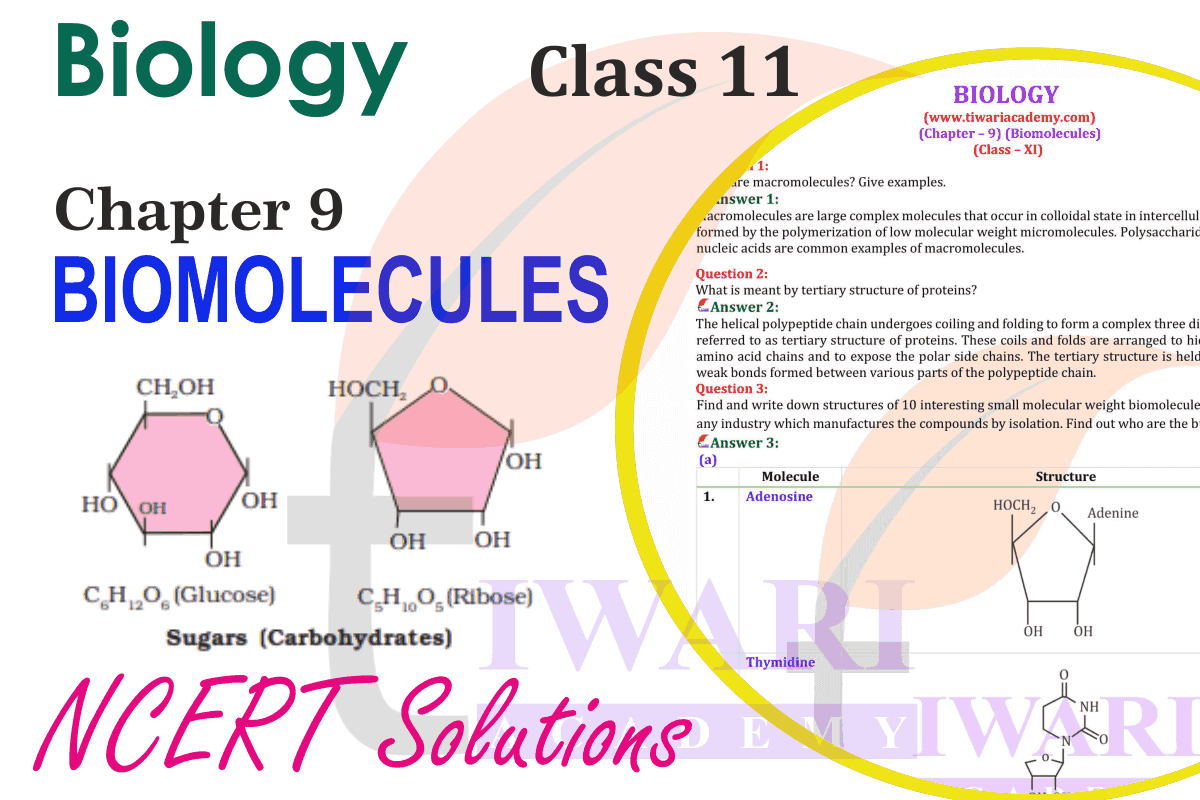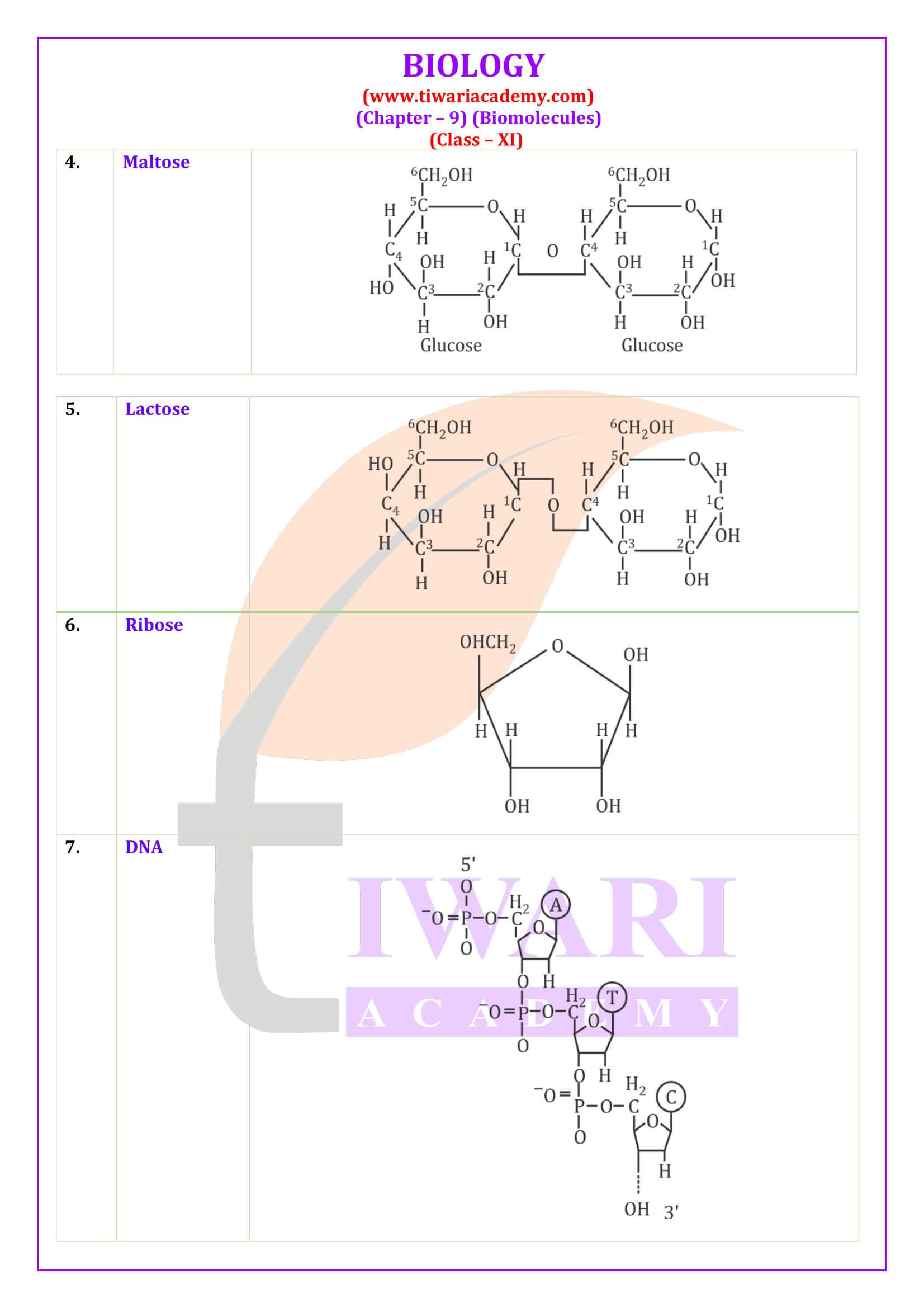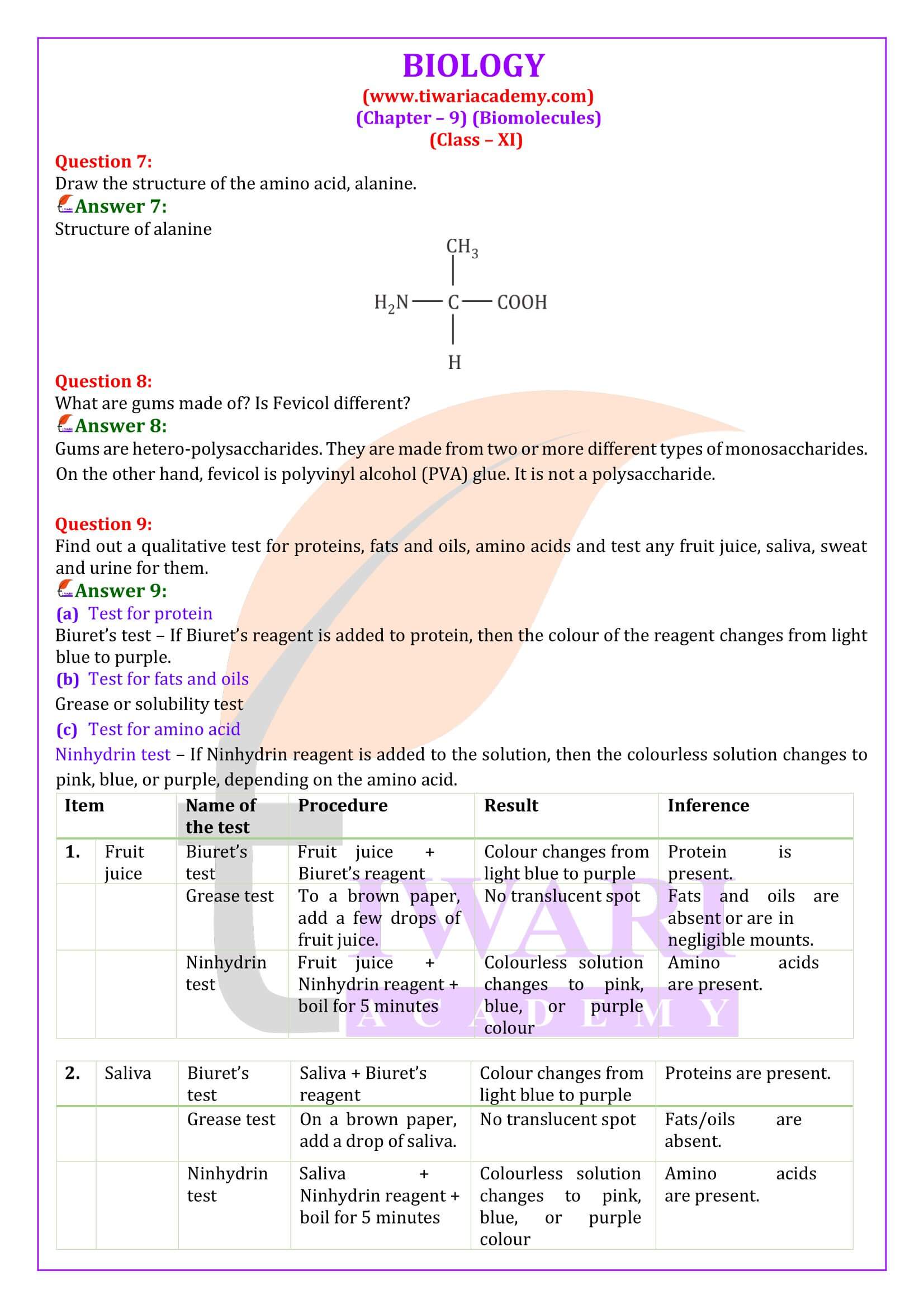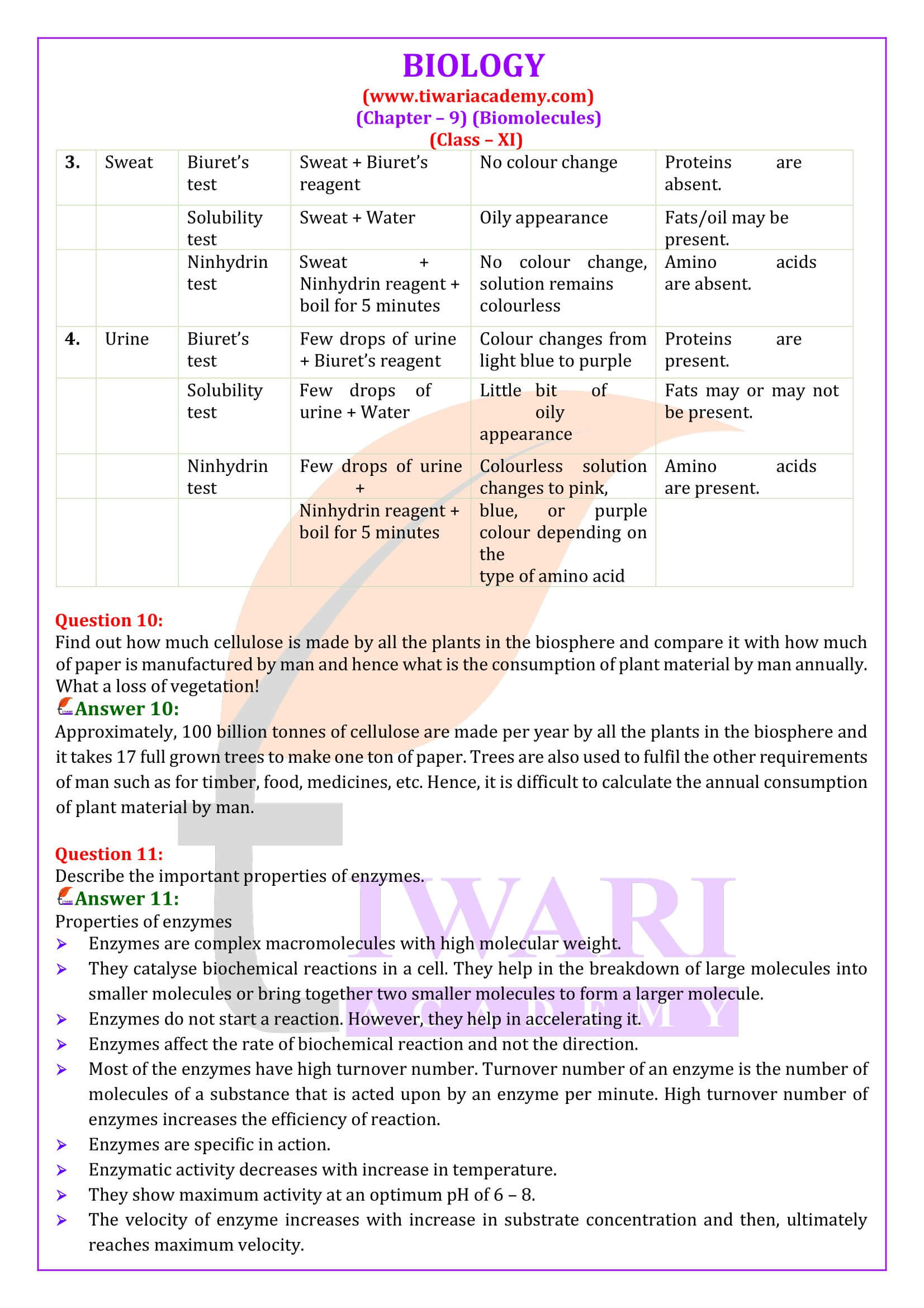NCERT Solutions for Class 11 Biology Chapter 9 Biomolecules in Hindi and English Medium PDF format to free download or Study online without downloading updated for new academic session 2025-26. NCERT Solutions of other subjects are also available to free download. Visit here to Ask Your Questions and to answer the questions asked by others.
NCERT Solutions for Class 11 Biology Chapter 9

| Class: 11 | Biology |
| Chapter 9: | Biomolecules |
| Content: | Exercises and Extra Question Answers |
| Mode of Content: | PDF, Images, Text and Videos Format |
| Academic Session: | 2025-26 |
| Medium: | Hindi and English Medium |
Class 11 Biology Chapter 9 Solutions in English
NCERT Solutions for Class 11 Biology Chapter 9 are given below to download in PDF format. All the NCERT Solutions are updated according to NCERT Books 2025-26 for new academic session based on new CBSE Syllabus. Join the Discussion forum to ask your doubts. Class 10 students can give 12th exams without doing 11th from NIOS board.

Important Notes on Biomolecules
1. Polysaccharides: These are long chain of polymers of monosaccharides.
2. Starch: Store house of energy in plant tissues. Forms helical secondary structures, made of only glucose monomers.
3. Cellulose: Homopolymer of glucose. It does not certain complex helices. Cotton fible is cellulose.
4. Glycogen: Is a branched homopolymer, found as storage polysaccharide in animals.
5. Inulin: Is a polymer of fructose.
6. Chitin: Chemically modified sugar (amino-sugars) N-acetyl galactosamine form exoskeleton of arthropods; heterpolymer.
DNA STRUCTURE
1. Watson and Crick Model: DNA is a right handed, double helix of two polynucleotide chains, having a major and minor groove. The two chains are antiparallel, and held together by hydrogen bonds (two between A and T and three between C and G). The backbone is formed by sugar-phosphatesugar chain.
2. The nitrogen bases are projected more or less perpendicular to this, backbone and face inside. The pitch is 34A°. At each step of ascent, the strand turns 36°. The rise per base pair is 3.4°A, so one full turn involves ten base pairs.
Lipids
1. Water insoluble, containing C, H, O.
2. Fats on hydrolysis yield fatty acids.
3. Fatty acid has a carboxyl group attached to an R group (contains 1 to 19 carbons).
4. Fatty Acids: Saturated: With single bonds in carbon chain, e.g., Palmitic acid, butyric acid.
5. Unsaturated: With one or more double bonds, e.g., oleic acid, linoleic acid.
Important Questions on 11th Biology Chapter 9
What are macromolecules? Give examples.
Macromolecules are large complex molecules that occur in colloidal state in intercellular fluid. They are formed by the polymerization of low molecular weight micromolecules. Polysaccharides, proteins, and nucleic acids are common examples of macromolecules.
What is meant by tertiary structure of proteins?
The helical polypeptide chain undergoes coiling and folding to form a complex three dimensional shape referred to as tertiary structure of proteins. These coils and folds are arranged to hide the non-polar amino acid chains and to expose the polar side chains. The tertiary structure is held together by the weak bonds formed between various parts of the polypeptide chain.
Proteins have primary structure. If you are given a method to know which amino acid is at either of the two termini (ends) of a protein, can you connect this information to purity or homogeneity of a protein?
Yes, if we are given a method to know the sequence of proteins, we can connect this information to the purity of a protein. It is known that an accurate sequence of a certain amino acid is very important for the functioning of a protein. If there is any change in the sequence, it would alter its structure, thereby altering the function. If we are provided with a method to know the sequence of an unknown protein, then using this information, we can determine its structure and compare it with any of the known correct protein sequence. Any change in the sequence can be linked to the purity or homogeneity of a protein. For example, any one change in the sequence of haemoglobin can alter the normal haemoglobin structure to an abnormal structure that can cause sickle cell anaemia.
Find out and make a list of proteins used as therapeutic agents. Find other applications of proteins (e.g., cosmetics, etc.)
Proteins used as therapeutic agents are as follows: Thrombin and fibrinogen – They help in blood clotting. Antigen (antibody) – It helps in blood transfusion. Insulin – It helps in maintaining blood glucose level in the body. Renin – It helps in osmoregulation. Proteins are also commonly used in the manufacture of cosmetics, toxins, and as biological buffers.
Can you describe what happens when milk is converted into curd or yoghurt from your understanding of proteins?
Proteins are macromolecules formed by the polymerization of amino acids. Structurally, proteins are divided into four levels. Primary structure – It is the linear sequence of amino acids in a polypeptide chain. Secondary structure – The polypeptide chain is coiled to form a three-dimensional structure. Tertiary structure – The helical polypeptide chain is further coiled and folded to form a complex structure. Quaternary structure – More than one polypeptide chains assemble to form the quaternary structure. Milk has many globular proteins. When milk is converted into curd or yoghurt, these complex proteins get denatured, thus converting globular proteins into fibrous proteins. Therefore, by the process of denaturation, the secondary and tertiary structures of proteins are destroyed.
Can you attempt building models of biomolecules using commercially available atomic models (Ball and Stick models).
Ball and stick models are 3-D molecular models that can be used to describe the structure of biomolecules. In ball and stick model, the atoms are represented as balls whereas the bonds that hold the atoms are represented by the sticks. Double and triple bonds are represented by springs that form curved connections between the balls. The size and colour of various atoms are different and are depicted by the relative size of the balls. It is the most fundamental and common model of representing biomolecular structures. In the above ball and stick model of D-glucose, the oxygen atoms are represented by red balls, hydrogen atoms by blue balls, while carbon atoms are represented by grey balls.
Attempt titrating an amino acid against a weak base and discover the number of dissociating (ionizable) functional groups in the amino acid.
Titrating a neutral or basic amino acid against a weak base will dissociate only one functional group, whereas titration between acidic amino acid and a weak acid will dissociate two or more functional groups.
What are gums made of? Is Fevicol different?
Gums are hetero-polysaccharides. They are made from two or more different types of monosaccharides. On the other hand, fevicol is polyvinyl alcohol (PVA) glue. It is not a polysaccharide.
Find out how much cellulose is made by all the plants in the biosphere and compare it with how much of paper is manufactured by man and hence what is the consumption of plant material by man annually. What a loss of vegetation!
Approximately, 100 billion tonnes of cellulose are made per year by all the plants in the biosphere and it takes 17 full grown trees to make one ton of paper. Trees are also used to fulfil the other requirements of man such as for timber, food, medicines, etc. Hence, it is difficult to calculate the annual consumption of plant material by man.
Describe the important properties of enzymes.
Properties of enzymes Enzymes are complex macromolecules with high molecular weight. They catalyse biochemical reactions in a cell. They help in the breakdown of large molecules into smaller molecules or bring together two smaller molecules to form a larger molecule. Enzymes do not start a reaction. However, they help in accelerating it. Enzymes affect the rate of biochemical reaction and not the direction. Most of the enzymes have high turnover number. Turnover number of an enzyme is the number of molecules of a substance that is acted upon by an enzyme per minute. High turnover number of enzymes increases the efficiency of reaction. Enzymes are specific in action. Enzymatic activity decreases with increase in temperature. They show maximum activity at an optimum pH of 6 – 8. The velocity of enzyme increases with increase in substrate concentration and then, ultimately reaches maximum velocity.
Bonds
1. Peptide bond-formed between the carboxyl (-COOH) group of one amino acid, and the amino (- NH2) group of the next amino with the elimination of water moiety, (dehydration).
2. Glycosidic bond-bond formed between two carbon atoms of two adjacent monosaccharides., by dehydration.
3. Phosphodiester bond-bond formed in nucleic acids where in a phosphate moiety links the 3-carbon of one sugar of one nucleotide to the 5-carbon of the sugar of the succeeding nucleotide. (The bond between phosphate group and hydroxyl group of sugar).









